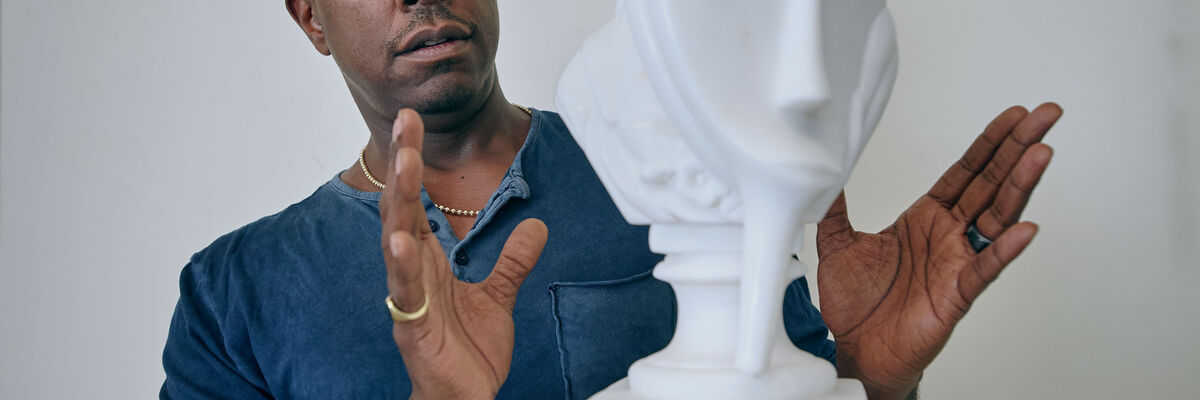
The Bravery of Sanford Biggers
by Sophie Lucido Johnson (MFA 2017)
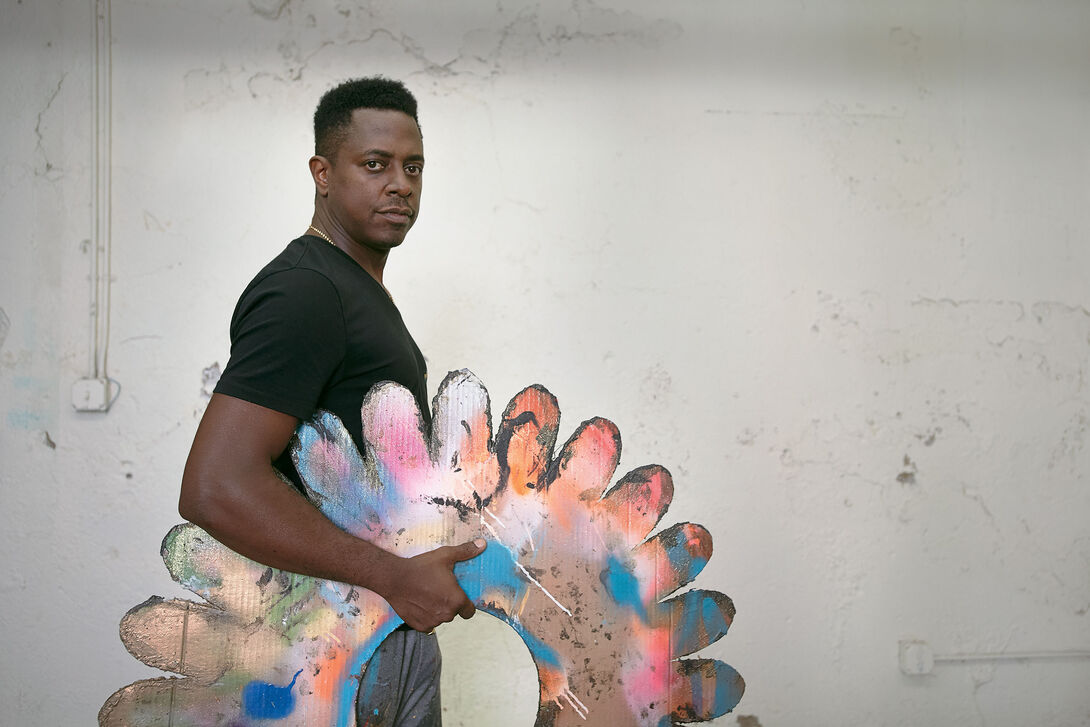
It’s hard to find a single category for Sanford Biggers.
You could say he’s a massive installation sculptor, but that would neglect his knack for working on smaller scales with textiles or ceramics. You could say he’s a maverick, but that leaves out that Biggers (MFA 1999) is one of the greatest living collaborators—with partners both living and dead—in the United States. He is often classified as a visual artist, but even that isn’t quite right: Biggers put together a multimedia concept band called Moon Medicin, which performed a singular and experiential concert at the Kennedy Center.
Ultimately, just one word spans the many Venn diagrams where his career fits, and the word is so broad that it’s a little unsatisfying: Biggers is an artist.
“I think I make art—I’ve been doing it all my life, basically—to sort through ideas and process information,” Biggers says. “I’m very much attached to objects and images, and I see them as gateways to engaging with deeper conversations that I have, and deeper conversations with society and culture in general.”
Biggers grew up in Los Angeles, where his parents kept a lot of art around. His cousin was the muralist John Biggers, and he cites that early experiences with his cousin’s work solidified the idea that being an artist was a viable career path.
“I actually started creating as more of a musician than as a visual artist, from taking piano lessons to gradually learning how to play by ear, and I was doing that from the ages of 9 to probably 12 or 13 or so,” he says. When he started listening to jazz—Biggers names Miles Davis, Billie Holiday, Mahalia Jackson, and Ray Charles as influences—playing by ear got more difficult, so he started to draw pictures of the people he heard on his records instead.
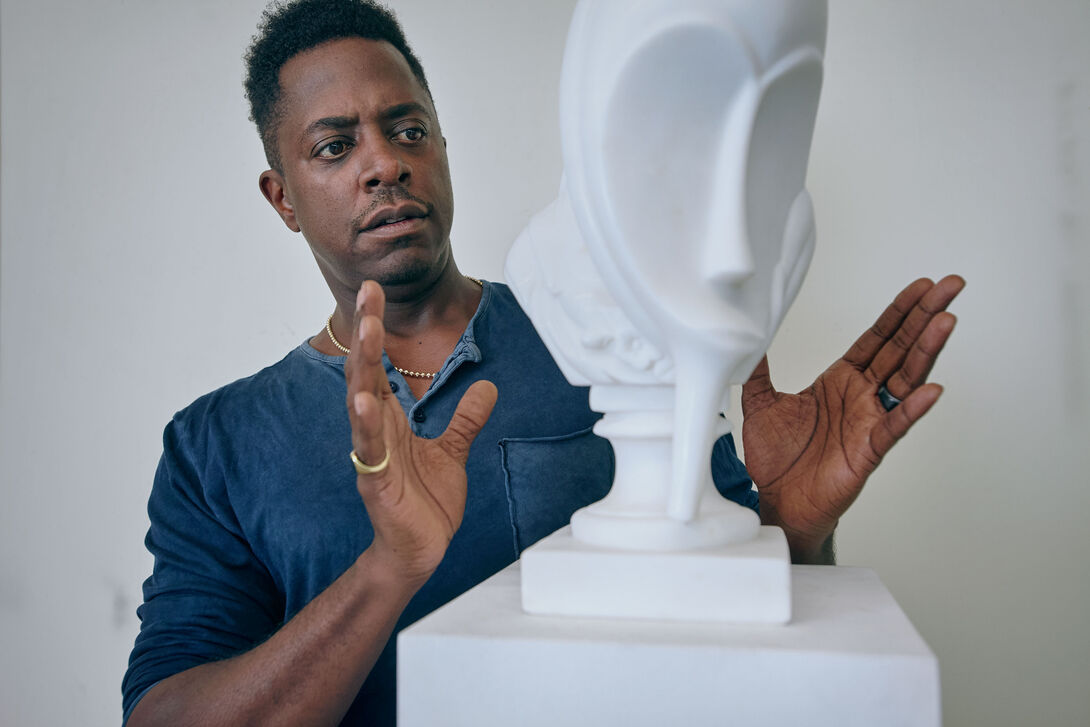
After receiving his Bachelor of Arts from the historically Black men’s college Morehouse, Biggers was admitted into the Painting and Drawing program at SAIC, but, as he puts it, “I did not paint a single thing the entire time. But that’s specifically why I went there; because at the time I was going there, it was one of the only schools that prominently and proudly said that they were interdisciplinary.”
SAIC gave Biggers the opportunity to work in the Sound; Film, Video, New Media, and Animation; and Sculpture departments, as well as to collaborate with people he’s still in touch with today. This interdisciplinary practice ultimately embedded itself into Biggers’ oeuvre, allowing him to switch artistic roles at the wave of a finger. Throughout his schooling, Biggers continued to be influenced by African American history and the African diaspora in America and internationally. It became paramount to him for his work to “shine a light on the stories and histories that we weren’t taught in school and that have not been mainstreamed at all in our country,” as he puts it.
From the start of his career, this history has been a part of Biggers’ work; he is uncompromising about telling the whole truth of the past. This is intentional, and it takes courage. Biggers has had to fight from the beginning.
While he was still an undergraduate student, Biggers entered a city-wide art contest. He was a sculptor’s apprentice at the time, and he knew what piece he wanted to submit: a metal disk polished to a mirror-like surface with a rusted chain that came off and fell into a rusty steel pipe with the Georgia state flag in it. (The Georgia state flag had the Confederate flag integrated onto it at the time.) His mentor considered the piece, but suggested he change it. Biggers did.
But he couldn’t sleep the night before the contest. And so in the early hours of the next morning, he got in his car and swapped the new piece out for the original one. It ended up winning second prize.
When the newspaper arrived to take pictures of the winning pieces, they refused to photograph the flag element. That wasn’t going to fly with Biggers.
“I ended up standing in front of the entire piece and said, ‘No pictures at all. If you can’t take a picture of the full piece, then there’s no reason to take a picture at all.’ So that was a statement,” he says.
It was just the beginning of a career in art-making statements, each of them thoughtful, courageous, and deep. And it’s difficult to describe his work, because, as Biggers himself concedes, the power of his pieces often demands physical presence.
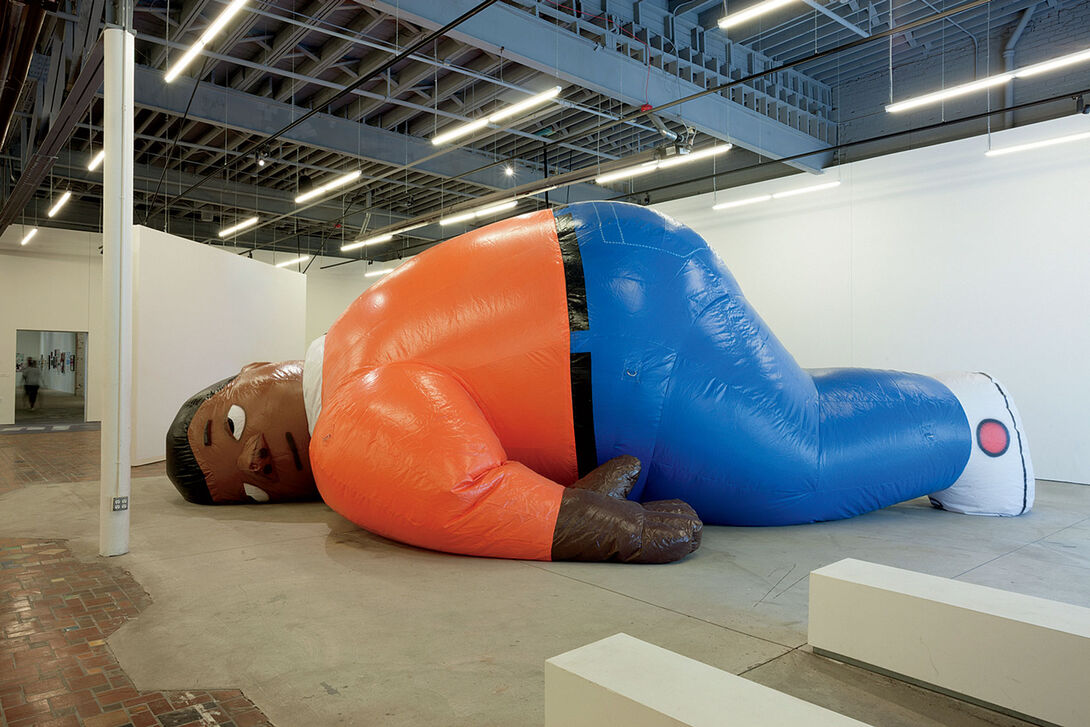
Take, for example, Lotus, which debuted at a small solo show in 2011 at the Brooklyn Museum. From a distance, it’s a lovely white flower cast in glass, serene and suspended mid-air by a perfectly round hanging circle. But when the viewer gets up close, it becomes clear that the flower is composed of slave ships, and the texture of the piece is structured from human bodies, brutally crammed together.
Or the more controversial Laocoön (Fatal Bert), which debuted at Miami Beach’s Art Basel in December 2015. The enormous vinyl inflatable sculpture looks like Bill Cosby’s Fat Albert lying on the ground and bringing to mind—especially given the piece’s name and its sonic similarity to Laquan McDonald’s—the countless bodies of unarmed Black people shot and killed by the police.
After Biggers finishes a piece, it becomes the viewers’ job to discuss, interpret, and find meaning in it.
Biggers says that his audience shouldn’t be pinned down and he makes work for everyone. “I try to make the work enticing and visually interesting to draw people in, and then the deeper they get in, if they spend a little time, they’ll start to peel back the different layers of meaning and context,” he says.
In a way, Biggers intentionally collaborates with his audience. He is interested in making work that brings people in, and then allows them to add their own history and experiences to their understanding of the work. This necessitates a diversity of complex understandings, which, ideally, brings audiences into conversation in order to further deepen the pieces’ meanings.
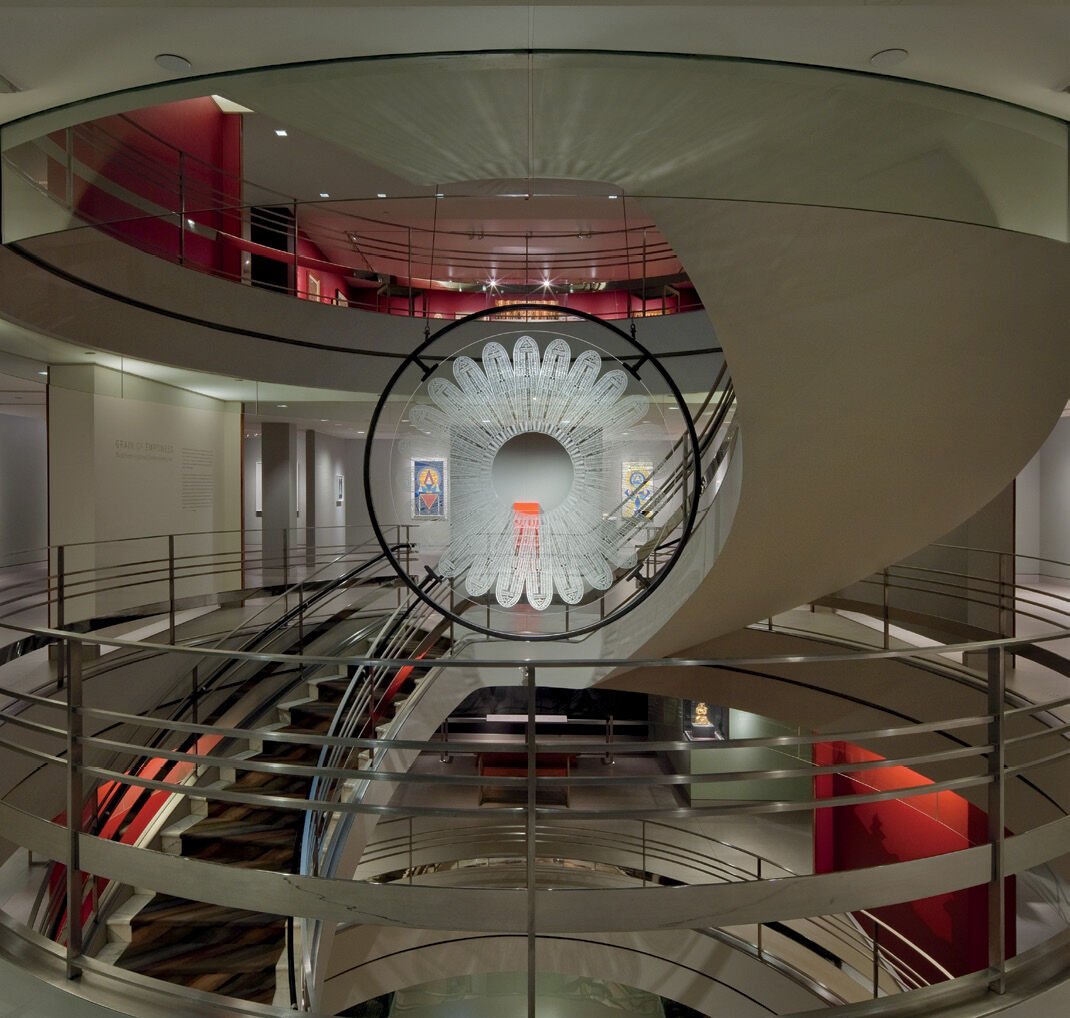
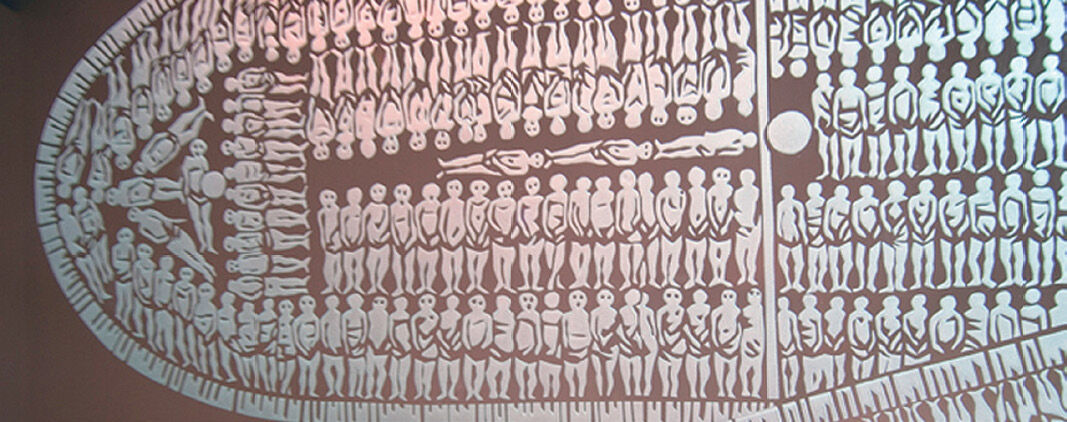
His audience is not his only unknowing collaborator: Biggers does a lot of work that builds upon both original artwork and the destruction of artwork from the past. He’s currently working on a series of marble sculptures titled Chimeras, in which he fuses classical Greco and Roman figures with traditional and contemporary African sculptures and masks.
“So you might see, let’s say, the body of Spartacus with a mask from the Fang culture of Africa. I think these are sculptural forms that we all have some familiarity with. Anyone who’s gone to an encyclopedic museum will have seen examples of both of those genres. But the intersection, or at least the intersection I’m imposing on them, I find particularly interesting,” Biggers says.
There’s an added layer here, too: While the typical museum viewer imagines European sculptures as monochromatic or white, Biggers found that several of them were actually polychromatic and painted in bright colors that have worn off over time.
“That means the way we’ve been perceiving that sculpture is totally whitewashed, literally whitewashed,” Biggers says. He adds that in contrast, African sculptures that museumgoers are used to seeing as monochromatically brown or black also originally had pigments, beads, and various colorful textural elements that were removed before the sculptures were put on display. He describes these sculptures as being “blackwashed, in a sense.”
“So what I’m doing now is taking them even to a third level of removal, another level of removal, by putting them together and then rendering them in marble,” Biggers says.
While the choice to make art with content that’s politically charged is brave, Biggers is careful about where he situates himself inside movements like Black Lives Matter.
“I do have very charged and loaded content in my work. I do hope that it inspires people to think differently and consider things in a deeper way. But at the same time, I don’t confuse it with the very hard activist work that many people are doing out in the field that are looking at safety and freedom and so on,” he says. “I’m informed and inspired by those people’s acts and my means of communicating them is through art, so that’s where I pick up the challenge.”
It became paramount to Biggers for his work to “shine a light on the stories and histories that we weren’t taught in school and that have not been mainstreamed at all in our country.”
Biggers acknowledges the importance of collaboration in his work and also the variety of his media. He’s currently working on marble sculptures, quilt paintings, an experimental musical outfit, a set design for a libretto, and consultation on a feature-length film.
“The message can be translated into different forms, and I’m sort of guided by themes rather than materials. In that respect, I’m very open to working in different forms, because I think the message of all the things I work on is very in sync with one another,” he says.
That message is a battle cry for audiences to join him in this critical work. And the work, as Biggers puts it, is to “rewrite history, combat historical amnesia, and inspire.”
